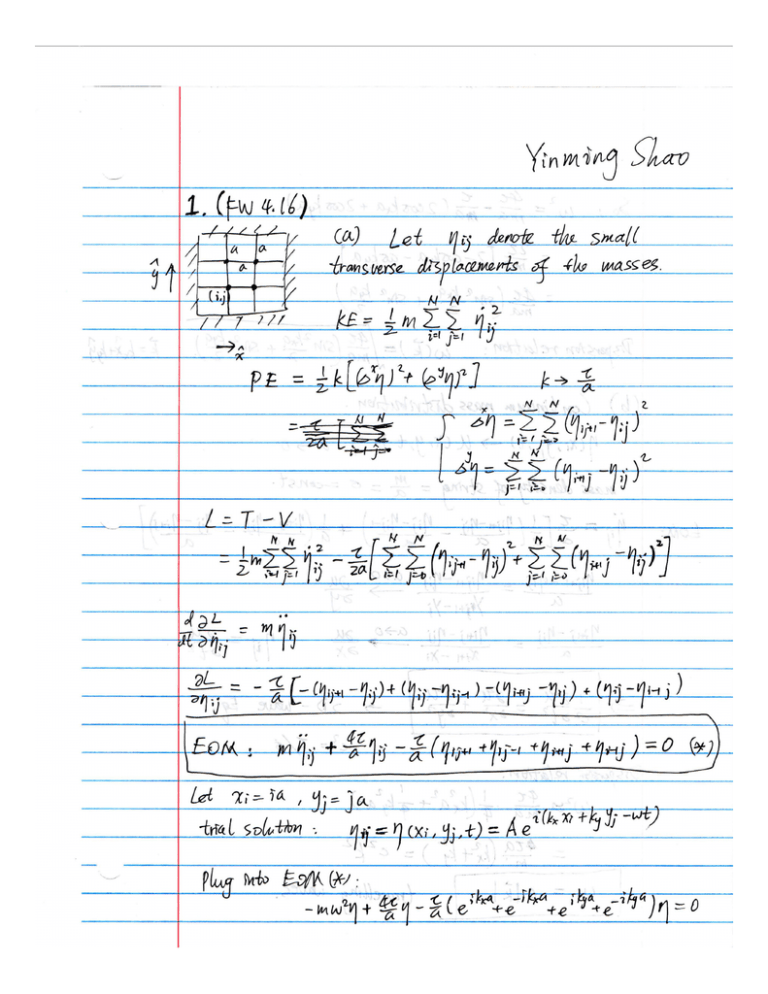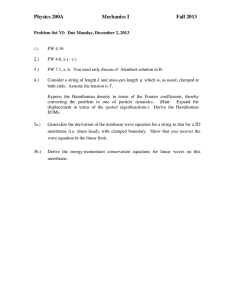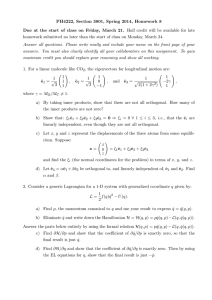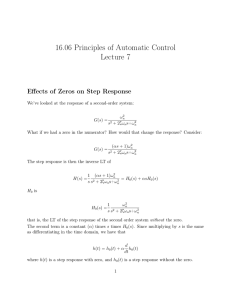Document 10986525
advertisement

5 6 7 8 9 10 Physics 200A Homework 6.4 Mark Derdzinski December 2, 2013 Problem 4 Solution Recall the Lagrangian density for a continuous string of length L with constant density µ and tension τ clamped at both ends: µ 2 τ 2 y − yx (1) 2 t 2 where yt and yx are the derivatives of the position y(x, t) with respect to t or x. We want to express the Lagrangian, and eventually the Hamiltonian, in terms of fourier coefficients. We will expand y(x, t) in the (complete) basis of spatial eigenfunctions L= y(x, t) = ∞ X Cn ρn (x) cos(ωn t + φn ) = n=1 ∞ X An (t)ρn (x) (2) n=1 Where the spatial eigenfunctions ρn (x) are given by ρn (x) = ∞ X 2 1 ( ) 2 sin(kn x) Lµ (3) n=1 Note our spatial eigenfunctions satisfy the orthonormality condition Z L ρn (x)ρm (x)σdx = δnm (4) 0 We are now equipped to describe the system in terms of the time-dependent fourier coefficients. Suppressing x and t for clarity, the Lagrangian density expanded in fourier series becomes "∞ #" ∞ # "∞ #" ∞ # X X µ X τ X dρn dρm L= Ȧn ρn Ȧm ρm − An Am (5) 2 2 dx dx n=1 m=1 n=1 m=1 If we integrate over x to find the full Lagrangian, we can exploit the orthonormality of the ρn to simplify the product of sums: L(An , A˙n , t) = Z L 0 2 τ kn µ Ldx = ∞ ∞ i 1 X 2 τ kn2 2 1 Xh 2 Ȧn − An = Ȧn − ωn2 A2n 2 µ 2 n=1 (6) n=1 Where we have used the fact = c2 kn2 = wn2 . We are now equipped to find the Hamiltonian in terms of the fourier coefficients. The generalized momentum is πn = dL = A˙n dA˙n 1 (7) And so the Hamiltonian is given by H(An , Ȧn , t) = ∞ X n πn Ȧn − L = ∞ 1 X 2 πn + ωn2 A2n 2 (8) n=1 The Hamiltonian EOM for the fourier coefficients is now simply dH dAn =⇒ Än = −ωn2 An π̇n = − (9) Note the Hamiltonian can be expressed in terms of a+ n = πn + ıωn An a− n = πn − ıωn An ∞ 1X + − a a =⇒ H = 2 n n n (10) − The a+ n and an are analogous to creation and annihilation operators for our purely classical system, where the zero-point energy is vanishing due to the classical commutator [πn , An ] = 0 . 2 13 14 15 16








